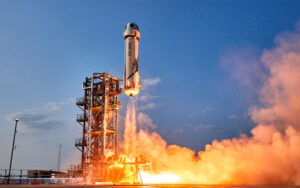ESA and NASA: Closer Than Ever
17th Aug 2022
Imagine the world’s most influential countries working together to improve humankind’s prospects in space. Despite recent conflicts and aggression involving other space agencies, the state of the ESA – NASA relationship shows that space agencies can still work together to wonderful effect.
In an ideal world, countries would share technology. A united, global effort would enhance the prospects of achieving more out of satellites and space exploration. Sadly, this isn’t an ideal world.
Though at times the ISS has been a wonderful symbol of collaboration, the recent decision from Russia to pull out of involvement is a blow to the space sector in general. This and other acts have made the former partner more of an outcast. However, the strife with Roscosmos has brought ESA and NASA even closer together.
A History of ESA and NASA
The pasts of these two agencies are interlinked, whether deliberately or not. For example, in the 1950s, a huge number of the most talented scientists in Europe left to work for NASA, due to their exciting and progressive projects.
NASA dates back to the 1940s, with the formation of the National Advisory Committee for Aeronautics (NACA). The committee experimented with missiles and satellites. Soviet progress in space pushed the US congress into further action, and President Dwight Eisenhower organized a “Special Committee on Space Technology,” in January 1958. The result? NASA was formed in July of the same year.
ESA transitioned into its current state by the time NASA had put people on the moon for the last time, which shows how far ahead the US was in this respect.
It was 1958, the year of NASA’s foundation and not long after the shock of the Sputnik missions, that Edoardo Amaldi and Pierre Auger would meet to discuss the need for Western European countries to collaborate. At this time, eight representatives from different European countries would attend, and created two agencies: The ELDO (European Launcher Development Organisation), and the ESRO (European Space Research Organisation).
These agencies struggled, partially due to underfunding, but real progress started when the ESA in its current form superseded the original European agencies. The 10 founding nations signed the convention in 1975. The countries involved were Belgium, Denmark, France, West Germany, Italy, the Netherlands, Spain, Sweden, Switzerland, and the United Kingdom. Now, 22 European states contribute to the agency.
The ESA and NASA Working in Unison
It wouldn’t be long until the ESA and NASA were working together. The International Ultraviolet Explorer (IUE) was the first high-profile project in which both agencies contributed. They launched the high-orbit telescope in 1978, and it provided data to Earth for 18 years.
There was a history of collaboration in the 80s and 90s, too. ESA collaborated with NASA on Ulysses and the Hubble Space Telescope. They launched the Cassini–Huygens space-research mission in 1997 to gather information on Saturn and its signature rings.
The ESA’s involvement was far from a token effort, either. Dornier Systems, an aircraft manufacturer based in Germany built the ESA-designed Ulysses.
Russian Conflict in Ukraine, and the Implications for Space Agencies
The geopolitical situation has been tense, but not totally restrictive for the last 30 or 40 years. Russia collaborated on the ISS, and even been willing to assist with further missions such as the ExoMars mission. The wide-scale invasion of Ukraine on 24th February 2022 changed all that.
The events forced ESA Director General Josef Aschbacher to make a statement after severing ties with Russia’s space agency, Roscosmos, who have since pulled out of the ISS.
“Geopolitically, it is clear that we need to sever our ties with Russia, and this decision has been made by the member states. So yes, it’s really unfortunate for all the science and technology and the engineers who have been working on this for four decades. But there is no other choice to make.”
Dmitry Rogozin, the former fiery head of Roscosmos (recently replaced by Yuri Borisov), commented furiously about the ESA refusing to work with Russia on its Mars Rover, ExoMars.
“Has the head of the European Space Agency thought about the work of thousands of scientists and engineers in Europe and Russia which has been ended by this decision? Is he prepared to answer for sabotaging a joint Mars mission?”
One of the biggest implications of this split is that the ESA has moved closer to NASA, and will shift focus to achieving more with the American space agency.
ESA and NASA: The Present and Future
In 2020, NASA and ESA finalised their agreement to collaborate on the Artemis Gateway. The gateway is a “multi-purpose outpost orbiting the Moon that provides essential support for long-term human return to the lunar surface and serves as a staging point for deep space exploration.”
The agreement was also NASA’s first commitment to send international crew members to the lunar vicinity, and construction is due to begin after 2024.
Since the Ukraine conflict started, the ESA and NASA have signed further agreements, both related to the Artemis missions as well as the commitment of both agencies to work together on climate change reduction. The agencies will share data and work together on projects exploring the Earth System, gathering data, and understanding how space may play a vital role in tackling the climate crisis.
NASA has also committed to deliver the ESA’a Lunar Pathfinder craft into orbit, enabling the mission to provide commercial communication services to lunar orbiters as well as gathering data through a number of scientific experiments.
In June of 2022, NASA Administrator Bill Nelson and Josef Aschbacher signed multiple agreements to advance the space agencies’ cooperation on Earth science and Artemis missions. A statement from Bill Nelson boasted that the ESA and NASA contribute 70% of the space industry’s scientific research, and promises to “ set the standard for future international collaboration at a time when we need global collaboration most to tackle the climate crisis.”
NASA already works with ESA on the Gateway as well as the Sentinel-6 satellite, designed to gain accurate data on sea levels around the world, and the collaboration between the two agencies seems set to grow further with the lack of Russian cooperation.






Thank you for your comment! It will be visible on the site after moderation.